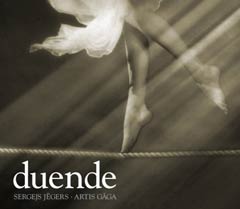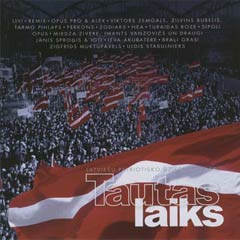
Continuing to showcase talented young artists, in 2007 record label Upe tuviem un tāliem released Duende, a collection of duets between countertenor Sergejs Jēgers and saxophonist Artis Gāga. The collaboration is unusual as it is just voice and saxophone—no orchestra, no piano, nothing besides the two musicians themselves (though one song does feature a tambourine). Can just two musicians, who are limited to playing one note at any given time (so there are not even any chords on this compact disc), engage the listener throughout the length of the album?
Jēgers has achieved much in a very short period of time. According to his Web site, he has given solo performances at the Latvian National Opera and has performed the role of the Angel in A. Rubinstein’s opera “The Demon,” as well as roles in other operas. His first solo CD, Ave Musica (2006), was a collection of sacred baroque songs. The album won the 2006 Latvian Music Recording Award for Best Debut.
Saxophonist, composer and arranger Gāga has performed with many different ensembles in a variety of styles. He has given concerts with various orchestras, including the Latvian National Symphony Orchestra, the Latvian National Opera Orchestra and other orchestras internationally. He has also performed with New Age group Kopējā izteiksme on its 2000 CD Putni maina virzienu. Earlier this year, he picked up three Latvian Music Recording Awards for 2007, including Best Debut Album and Best Instrumental, Film, or Theater Music Album for his solo CD, Mūzikālās impresijas: Zīmējumi debesīs.
Duende was recorded at the Sesava Lutheran Church, which, as the liner notes indicate, has excellent acoustics (proven admirably by this recording). Most of the songs on Duende are by French composers and, much like the songs on Ave Musica, are of a sacred nature. We get a performance of “Pie Jesu” from Gabriel Fauré’s “Requiem.” There are also two “Ave Marias” by Camille Saint-Saëns, not to mention “Amarilli, Mia Bella” by early Italian baroque composer Giulio Caccini. The CD also features the duo’s interpretation of the old French standard “Placer D’Amor” (elsewhere titled as “Plaisir d’amour”) by Jean Paul Martini.
The booklet features plenty of photos of the artists, as well as some philosophical musings by Latvian writers, and we also discover that the term “duende” is taken from Spanish poet Federico Garcia Lorca. I would not have minded if the recording company had dropped some of the deep thoughts and replaced them with perhaps a bit more information about how these two artists came to collaborate and their own thoughts on the collaboration. The liner notes are in Latvian and in English.
Though an unusual pair, the countertenor Jēgers and saxophonist Gāga have made one of the most interesting and absorbing recordings in recent memory. To answer the question from before, yes, these two artists, with just voice and saxophone, make for compelling listening. The melodies effortlessly flow between voice and saxophone, complementing each other with beautiful textures and deep emotions. The jury of the Latvian Music Recording Awards agreed and awarded the CD the Best Academic Music Award of 2007, acknowledging and rewarding the performance and talents of these two exceptional musicians.
Details
Duende
Sergejs Jēgers and Artis Gāga
Upe tuviem un tāliem, 2007
UPE TT 030
On the Web
Artis Gāga
Hear samples of Artis Gāga’s music, read about his life, learn about his concerts and recordings on this official Web site. EN LV
Kontrtenors Sergejs Jēgers
Sergejs Jēgers’ Web site includes his biography and information about his repertoire, recordings and foundation. LV





